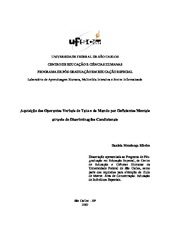Aquisição dos operantes verbais de tato e de mando por deficientes mentais através de discriminações condicionais

Ver/
Fecha
2007-02-28Autor
Ribeiro, Daniela Mendonça
Metadatos
Mostrar el registro completo del ítemResumen
The current study had the purpose of analyzing the acquisition of selection-based tacts through conditional discriminations and the emergence of these signs as topography-based tact and as mand by four mentally retarded, hearing-able adolescents with language delay and no previous experience with signs from Brazilian Sign Language (LIBRAS). Experimental stimuli were divided into three sets of six elements each. Set A consisted of signs from LIBRAS, presented through video as sample stimuli, set B consisted of pictures corresponding to the signs and set C consisted of three pairs of real objects corresponding to set B pictures. First, stimulus set B objects were presented to the participants in pairs: safe box and key, bottle and opener, juice and straw. In the presence of each pair, the participant was instructed to combine the objects to reach the content. Each trial was followed by the consumption of the preferred item each pair presented. Second, conditional discriminations between stimulus sets A and B (AB) were taught through matching-to-sample tasks. Correct choices were followed by verbal praise and tokens that could be exchanged with preferred items at the end of each session. Contingent upon incorrect choices, there was a two-second interval followed by the presentation of the next trial. After reaching criterion in selection-based tact (AB relation), tests for the emergence of BA relations, topography-based tact were introduced. During these tests, elements of set B stimuli were presented as sample, followed by oral instructions expressively asking the participant to emit the proper corresponding signs. Response set A was the set of signs from LIBRAS emitted by the participants. Contingencies for correct and incorrect responses were the same as in training. After that, a test for emergence of the verbal operant mand was introduced. Objects from set C were presented alone, one from each of the pairs presented in the first phase, and the participant was required to sign which was the missing object. Correct signs were followed by the object and the consumption of the preferred item. Results varied across participants. The three participants who completed the study met criterion in AB relations referring to selectionbased tact, however, for two of these participants, protracted training was necessary. Moreover they showed the emergence of at least one sign during BA relations. Conditional discriminations training through matching-to-sample tasks yielded promising results. However, some relevant variables still require greater experimental control. These variables are related to the instructions, the schedule of reinforcement and the criterion in experimental conditions. Only one participant was presented to the test for the emergence of mand verbal operant and presented positive results. This suggests that the manipulation of motivating operations can facilitate the emission of mand responses without direct training. Although data about the emergence of new behaviors seem optimistic greater generalization of results has to be obtained. Moreover, it is necessary to continue the investigation of the conditions under which the emergence of new behaviors occur.